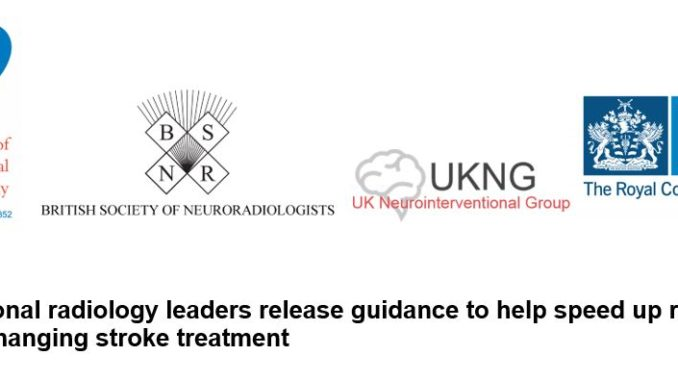 24 January 2018
(Last updated: 29 Jan 2020 13:15)
24 January 2018
(Last updated: 29 Jan 2020 13:15)
- Emergency mechanical thrombectomy removes blood clots in the brain and dramatically increases a stroke patient’s chance of a full recovery
- We do not have enough skilled doctors to provide the procedure – NHS England plans to roll out the technique nationally, but at least another 50 extra specially trained radiologists will be needed
- Now interventional radiology leaders have teamed up to produce guidance to help hospitals train more doctors in the technique
Leaders in interventional radiology have issued guidance to help hospitals train more specialist radiologists to perform life-changing stroke thrombectomy treatment.
The treatment is an interventional procedure which allows radiologists to remove a blood clot via a stent that is navigated up to the brain and pulls the clot out.
The “Supplementary Guidance to Facilitate the Training of Interventional Radiology Consultants to Undertake Stroke Thrombectomy” has been produced by The Royal College of Radiologists, the British Society of Interventional Radiology, the British Society of Neuroradiologists and the UK Neurointerventional Group.
To combat a UK-wide shortage of interventional neuroradiologists (INRs) – who normally perform stroke thrombectomy – the umbrella group is encouraging hospitals to support existing interventional radiologists to train in the new technique.
Currently, there are only 74 fully-trained INRs in England, however, official plans to roll out stroke thrombectomy would require at least 120 trained experts in England, with additional INR expertise needed across the UK.
The quick guidance document covers topics such as the agreements between doctors and their employer trusts to formalise training arrangements, what interventional radiologists learning stoke thrombectomy need to know about stroke management, and how mentoring and training takes place in practice.
Dr Andy Clifton, President of the British Society of Neuroradiologists, said:
“Stroke thrombectomy is a game-changer in the management of acute stroke. It is a technically challenging procedure that is currently carried out by interventional neuroradiologists.
“There is a shortage of INRs in UK and therefore to expedite roll out of this procedure across the UK, BSNR/UKNG has worked with our interventional radiology colleagues to facilitate and encourage trusts to consider appropriate formal training of their current consultant interventional radiologists in this technique.”
Dr Jai Patel, chair of The Royal College of Radiologists interventional radiology committee said: “Stroke thrombectomy can have a huge impact on the outcome and recovery of a stroke patient, but it is a time-sensitive intervention and needs to be performed by expertly trained interventional radiologists.
“Sadly, the NHS does not have the infrastructure and manpower to deliver this ground-breaking treatment. However, this collaboration between stroke thrombectomy experts and our practical guidance for doctors and hospitals is a great first step to making sure we have the skilled workforce we need so that more stroke victims can benefit.”
Dr Trevor Cleveland, President of the British Society of Interventional Radiology, said: “NHS England hopes that around 8,000 patients every year will be able to benefit from stroke thrombectomy, however, currently only a few hundred do so because we need more trained doctors.
“Training enough radiologists to carry out this specific life-changing technique will not happen over night, however, we hope to encourage and support clinicians and hospitals to invest their time and expertise to make the promised rollout of stroke thrombectomy services – at least in England – a reality.”
To view the guidance, please visit: https://www.rcr.ac.uk/sites/default/files/mt_interim_guidance_document_30-10-2017_final.pdf